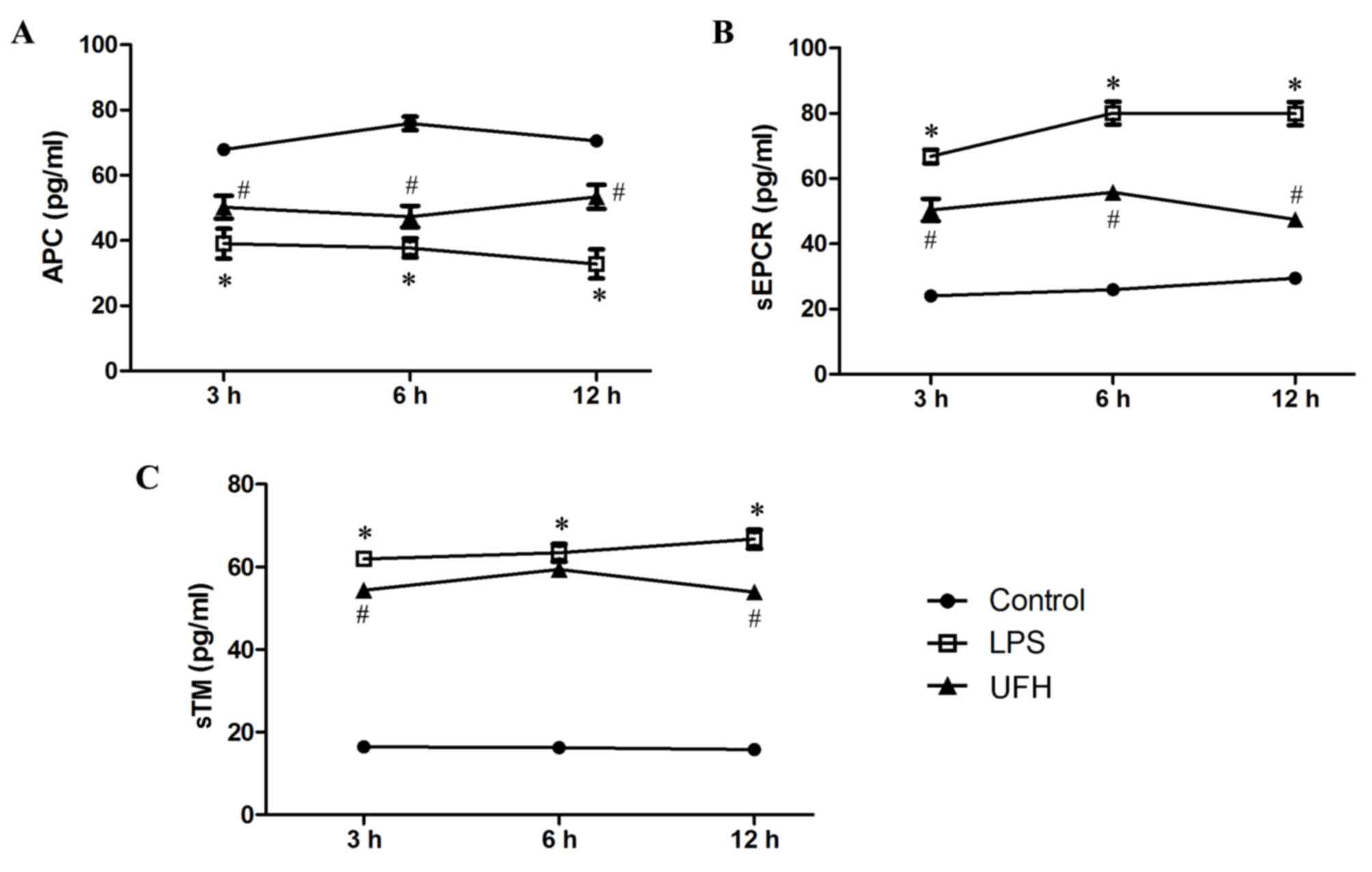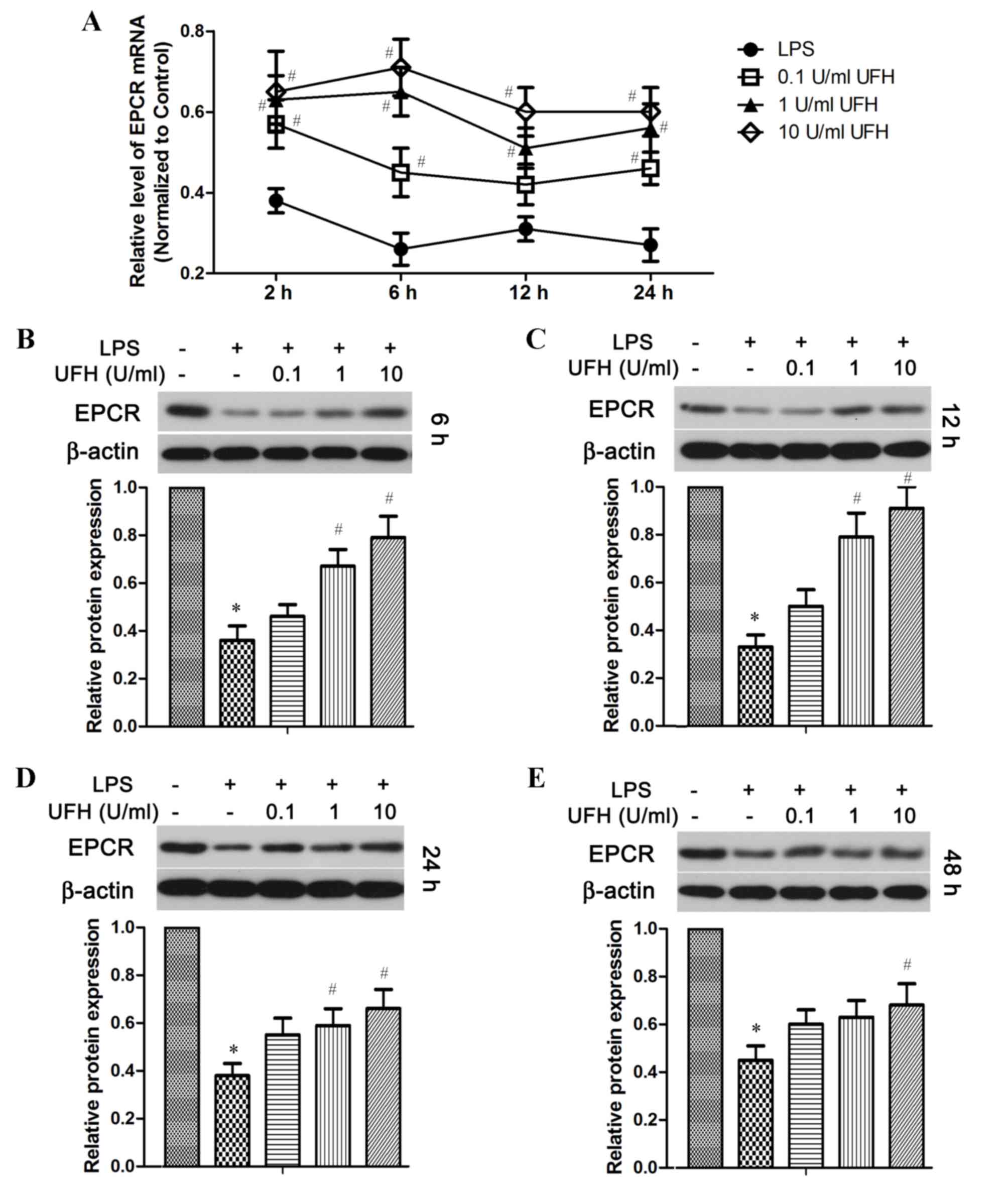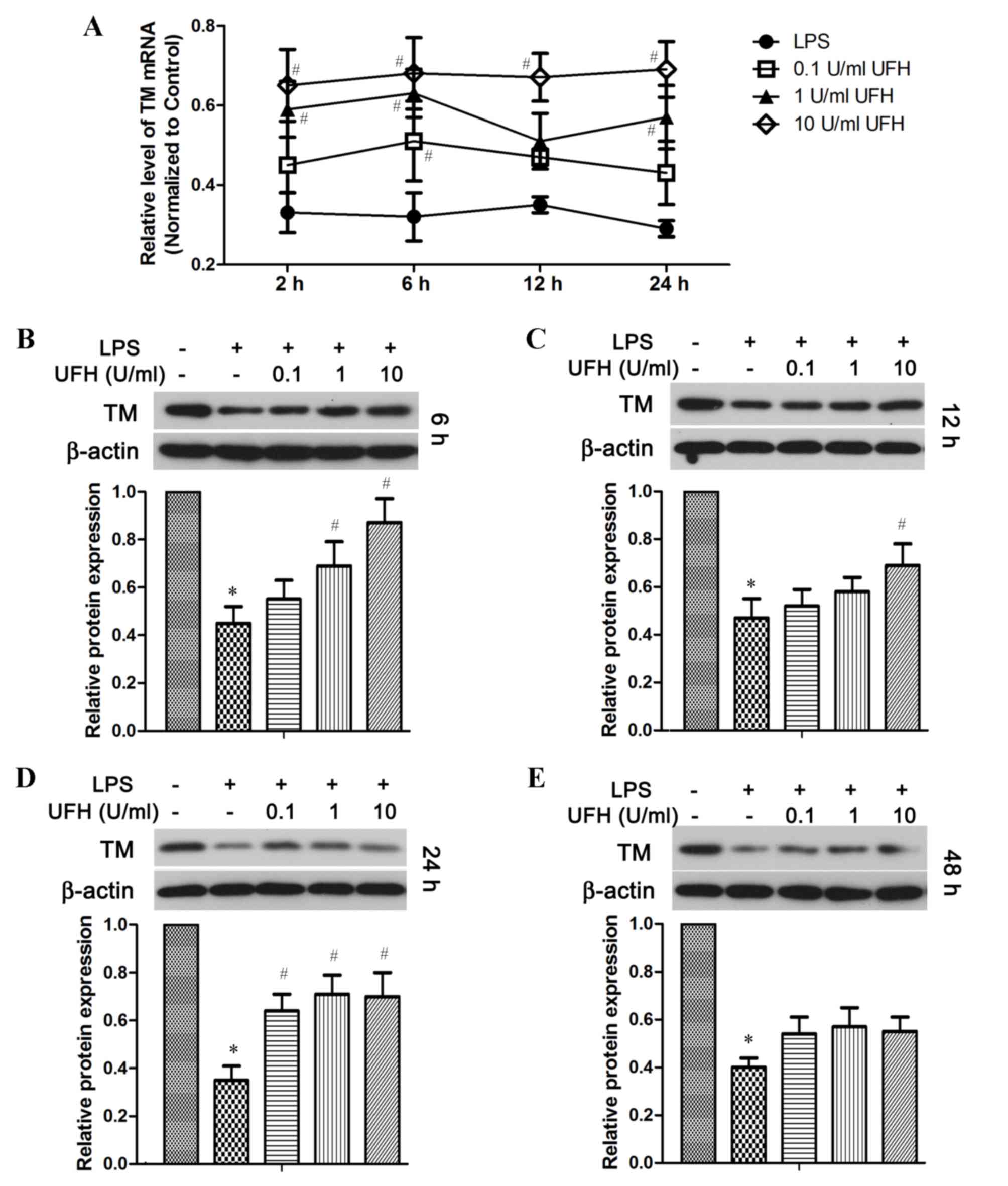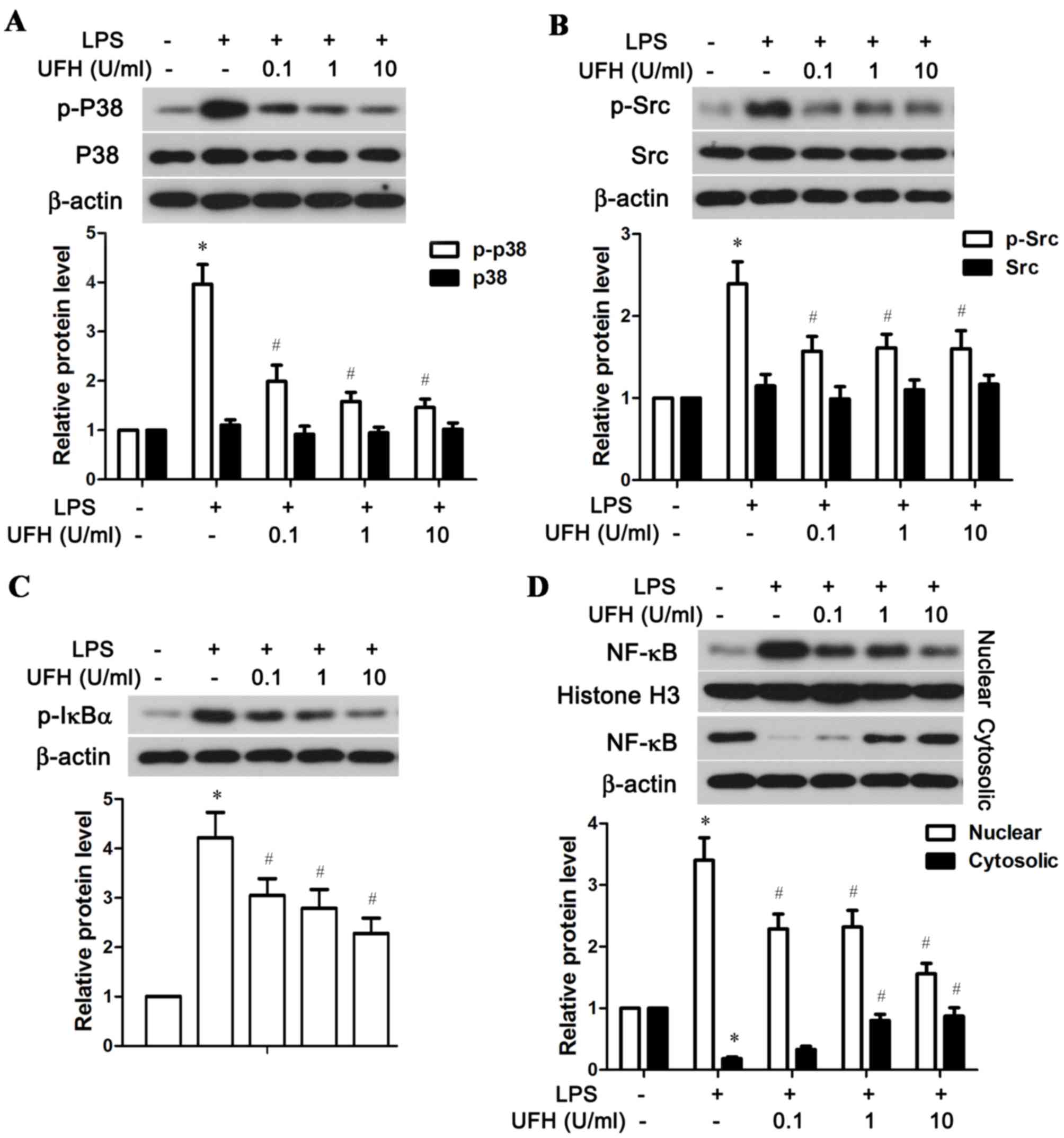|
1
|
Cohen J: The immunopathogenesis of sepsis.
Nature. 420:885–891. 2002. View Article : Google Scholar : PubMed/NCBI
|
|
2
|
Annane D, Bellissant E and Cavaillon JM:
Septic shock. Lancet. 365:63–78. 2005. View Article : Google Scholar : PubMed/NCBI
|
|
3
|
Levi M, van der Poll T and Büller HR:
Bidirectional relation between inflammation and coagulation.
Circulation. 109:2698–2704. 2004. View Article : Google Scholar : PubMed/NCBI
|
|
4
|
Opal SM and Esmon CT: Bench-to-bedside
review: Functional relationships between coagulation and the innate
immune response and their respective roles in the pathogenesis of
sepsis. Crit Care. 7:23–38. 2003. View
Article : Google Scholar : PubMed/NCBI
|
|
5
|
Schouten M, Wiersinga WJ, Levi M and van
der Poll T: Inflammation, endothelium, and coagulation in sepsis. J
Leukoc Biol. 83:536–545. 2008. View Article : Google Scholar : PubMed/NCBI
|
|
6
|
Esmon CT: The protein C pathway. Chest.
124 3 Suppl:26S–32S. 2003. View Article : Google Scholar : PubMed/NCBI
|
|
7
|
Van de Wouwer M, Collen D and Conway EM:
Thrombomodulin-protein C-EPCR system: Integrated to regulate
coagulation and inflammation. Arterioscler Thromb Vasc Biol.
24:1374–1383. 2004. View Article : Google Scholar : PubMed/NCBI
|
|
8
|
Miyazaki Y, Inoue T, Kyi M, Sawada M,
Miyake S and Yoshizawa Y: Effects of a neutrophil elastase
inhibitor (ONO-5046) on acute pulmonary injury induced by tumor
necrosis factor alpha (TNFalpha) and activated neutrophils in
isolated perfused rabbit lungs. Am J Respir Crit Care Med.
157:89–94. 1998. View Article : Google Scholar : PubMed/NCBI
|
|
9
|
Qu D, Wang Y, Esmon NL and Esmon CT:
Regulated endothelial protein C receptor shedding is mediated by
tumor necrosis factor-alpha converting enzyme/ADAM17. J Thromb
Haemost. 5:395–402. 2007. View Article : Google Scholar : PubMed/NCBI
|
|
10
|
Xu J, Qu D, Esmon NL and Esmon CT:
Metalloproteolytic release of endothelial cell protein C receptor.
J Biol Chem. 275:6038–6044. 2000. View Article : Google Scholar : PubMed/NCBI
|
|
11
|
Bemard GR, Ely EW, Wright TJ, Fraiz J,
Stasek JE Jr, Russell JA, Mayers I, Rosenfeld BA, Morris PE, Yan SB
and Helterbrand JD: Safety and dose relationship of recombinant
human activated protein C for coagulopathy in severe sepsis. Crit
Care Med. 29:2051–2059. 2001. View Article : Google Scholar : PubMed/NCBI
|
|
12
|
Bemard GR: Drotrecogin alfa (activated)
(recombinant human activated protein C) for the treatment of severe
sepsis. Crit Care Med. 31 1 Suppl:S85–S93. 2003. View Article : Google Scholar : PubMed/NCBI
|
|
13
|
Fowler RA, Hill-Popper M, Stasinos J,
Petrou C, Sanders GD and Garber AM: Cost-effective of recombinant
human activated protein C and the influence of severity of illness
in the treatment of patients with severe sepsis. J Crit Care.
18:181–194. 2003. View Article : Google Scholar : PubMed/NCBI
|
|
14
|
Martí-Carvajal AJ, Solà I, Gluud C,
Lathyris D and Cardona AF: Human recombinant protein C for severe
sepsis and septic shock in adult and paediatric patients. Cochrane
Database Syst Rev. 12:CD0043882012.PubMed/NCBI
|
|
15
|
Cornet AD, Smit EG, Beishuizen A and
Groeneveld AB: The role of heparin and allied compounds in the
treatment of sepsis. Thromb Haemost. 98:579–586. 2007.PubMed/NCBI
|
|
16
|
Li Y, Sun JF, Cui X, Mani H, Danner RL, Li
X, Su JW, Fitz Y and Eichacker PQ: The effect of heparin
administration in animal models of sepsis: A prospective study in
Escherichia coli-challenged mice and a systematic review and
metaregression analysis of published studies. Crit Care Med.
39:1104–1112. 2011. View Article : Google Scholar : PubMed/NCBI
|
|
17
|
Zhao D, Ding R, Mao Y, Wang L, Zhang Z and
Ma X: Heparin rescues sepsis-associated acute lung injury and
lethality through the suppression of inflammatory responses.
Inflammation. 35:1825–1832. 2012. View Article : Google Scholar : PubMed/NCBI
|
|
18
|
Wildhagen KC, de Frutos García P,
Reutelingsperger CP, Schrijver R, Aresté C, Ortega-Gómez A, Deckers
NM, Hemker HC, Soehnlein O and Nicolaes GA: Nonanticoagulant
heparin prevents histone-mediated cytotoxicity in vitro and
improves survival in sepsis. Blood. 123:1098–1101. 2014. View Article : Google Scholar : PubMed/NCBI
|
|
19
|
Ding R, Zhao D, Guo R, Zhang Z and Ma X:
Treatment with unfractionated heparin attenuates coagulation and
inflammation in endotoxemic mice. Thromb Res. 128:e160–e165. 2011.
View Article : Google Scholar : PubMed/NCBI
|
|
20
|
Li X, Zheng Z, Li X and Ma X:
Unfractionated heparin inhibits lipopolysaccharide-induced
inflammatory response through blocking P38 MAPK and NF-κB
activation on endothelial cell. Cytokine. 60:114–121. 2012.
View Article : Google Scholar : PubMed/NCBI
|
|
21
|
Li X, Zheng Z, Mao Y and Ma X:
Unfractionated heparin promotes LPS-induced endothelial barrier
dysfunction: A preliminary study on the roles of angiopoietin/Tie2
axis. Thromb Res. 129:e223–e228. 2012. View Article : Google Scholar : PubMed/NCBI
|
|
22
|
Li X, Li X, Zheng Z, Liu Y and Ma X:
Unfractionated heparin suppresses lipopolysaccharide-induced
monocyte chemoattractant protein-1 expression in human
microvascular endothelial cells by blocking Krüppel-like factor 5
and nuclear factor-κB pathway. Immunobiology. 219:778–785. 2014.
View Article : Google Scholar : PubMed/NCBI
|
|
23
|
National Research Council, . Guide for the
care and use of laboratory animals (8th edition). The National
Academies Press; Washington DC: 2011
|
|
24
|
Livak KJ and Schmittgen TD: Analysis of
relative gene expression data using real-time quantitative PCR and
the 2(-Delta Delta C(T)) method. Methods. 25:402–408. 2001.
View Article : Google Scholar : PubMed/NCBI
|
|
25
|
Mu E, Ding R, An X, Li X, Chen S and Ma X:
Heparin attenuates lipopolysaccharide-induced acute lung injury by
inhibiting nitric oxide synthase and TGF-β/Smad signaling pathway.
Thromb Res. 129:479–485. 2012. View Article : Google Scholar : PubMed/NCBI
|
|
26
|
Hayashi T and Suzuki K: Changes of
expression of the protein C pathway components in LPS-induced
endotoxemia-implication for sepsis. Cardiovasc Hematol Disord Drug
Targets. 15:2–9. 2015. View Article : Google Scholar : PubMed/NCBI
|
|
27
|
Redini F, Tixier JM, Petitou M, Choay J,
Robert L and Hornebeck W: Inhibition of leucocyte elastase by
heparin and its derivatives. Biochem J. 252:515–519. 1988.
View Article : Google Scholar : PubMed/NCBI
|
|
28
|
Kenagy RD, Nikkari ST, Welgus HG and
Clowes AW: Heparin inhibits the induction of three matrix
metalloproteinases (stromelysin, 92-kD gelatinase and collagenase)
in primate arterial smooth muscle cells. J Clin Invest.
93:1987–1993. 1994. View Article : Google Scholar : PubMed/NCBI
|
|
29
|
Terada Y, Eguchi Y, Nosaka S, Toba T,
Nakamura T and Shimizu Y: Capillary endothelial thrombomodulin
expression and fibrin deposition in rats with continuous and bolus
lipopolysaccharide administration. Lab Invest. 83:1165–1173. 2003.
View Article : Google Scholar : PubMed/NCBI
|
|
30
|
Gao XH, Xu XX, Pan R, Li Y, Luo YB, Xia
YF, Murata K, Matsuda H and Dai Y: Saponin fraction from Astragalus
membranaceus roots protects mice against polymicrobial sepsis
induced by cecal ligation and puncture by inhibiting inflammation
and upregulating protein C pathway. J Nat Med. 63:421–429. 2009.
View Article : Google Scholar : PubMed/NCBI
|
|
31
|
Vignoli A, Marchetti M, Balducci D, Barbui
T and Falanga A: Differential effect of the low-molecular-weight
heparin, dalteparin, and unfractionated heparin on microvascular
endothelial cell hemostatic properties. Haematologica. 91:207–214.
2006.PubMed/NCBI
|
|
32
|
Faioni EM, Fontana G, Razzari C, Avagliano
L, Bulfamante G, Calvi E, Doi P and Marconi AM: Activation of
protein C in human trophoblasts in culture and downregulation of
trophoblast endothelial protein C receptor by TNF-α. Reprod Sci.
22:1042–1048. 2015. View Article : Google Scholar : PubMed/NCBI
|
|
33
|
Ishii H, Uchiyama H and Kazama M: Soluble
thrombomodulin antigen in conditioned medium is increased by damage
of endothelial cells. Thromb Haemost. 65:618–623. 1991.PubMed/NCBI
|
|
34
|
Song D, Ye X, Xu H and Liu SF: Activation
of endothelial intrinsic NF-{kappa}B pathway impairs protein C
anticoagulation mechanism and promotes coagulation in endotoxemic
mice. Blood. 114:2521–2529. 2009. View Article : Google Scholar : PubMed/NCBI
|
|
35
|
Menschikowski M, Hagelgans A, Eisenhofer G
and Siegert G: Regulation of endothelial protein C receptor
shedding by cytokines is mediated through differential activation
of MAP kinase signaling pathways. Exp Cell Res. 315:2673–2682.
2009. View Article : Google Scholar : PubMed/NCBI
|
|
36
|
Lo IC, Lin TM, Chou LH, Liu SL, Wu LW, Shi
GY, Wu HL and Jiang MJ: Ets-1 mediates platelet-derived growth
factor-BB-induced thrombomodulin expression in human vascular
smooth muscle cells. Cardiovasc Res. 81:771–779. 2009. View Article : Google Scholar : PubMed/NCBI
|
|
37
|
Wang C, Chi C, Guo L, Wang X, Guo L, Sun
J, Sun B, Liu S, Chang X and Li E: Heparin therapy reduces 28-day
mortality in adult severe sepsis patients: A systematic review and
meta-analysis. Crit Care. 18:5632014. View Article : Google Scholar : PubMed/NCBI
|
|
38
|
Zarychanski R, About-Setta AM, Kanji S,
Turgeon AF, Kumar A, Houston DS, Rimmer E, Houston BL, McIntyre L,
Fox-Robichaud AE, et al: The efficacy and safety of heparin in
patients with sepsis: A systemati review and metaanalysis. Crit
Care Med. 43:511–518. 2015. View Article : Google Scholar : PubMed/NCBI
|














